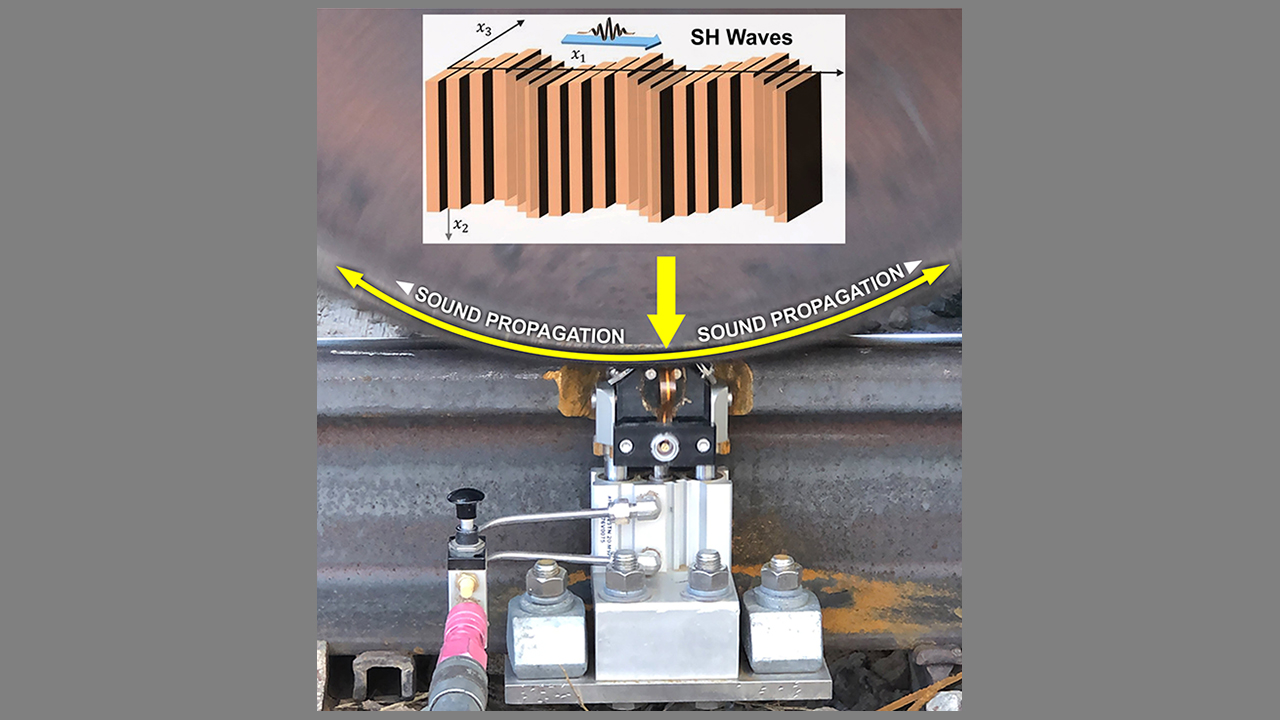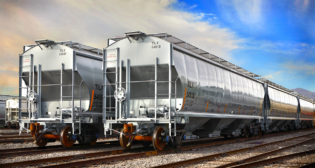
EMAT Update
Written by Anish Poudel, Ph.D., Principal Investigator I (NDT), Transportation Technology Center, Inc.
MXV RAIL R&D, RAILWAY AGE, SEPTEMBER 2023 ISSUE: MxV Rail continues to investigate innovative alternative in-motion wheel inspection technologies that could be used to detect and characterize internal fatigue cracks in the wheel rim while the wheels are in service. Unlike rails, railway wheels are not ultrasonically inspected for internal cracks/defects after the accumulation of traffic. However, finding both internal wheel cracks and internal rail head defects is important—a broken wheel derailment can be just as impactful as a derailment caused by a broken rail.
As part of the investigation, MxV Rail has been facilitating the development of an electromagnetic acoustic transducer (EMAT) nondestructive evaluation (NDE) technology that could be used to detect internal subsurface fatigue cracks in wheel rims. Because the ultrasound is generated directly within the material adjacent to the EMAT transducer, the EMAT systems being developed do not require a liquid couplant (consumable) between the transducer and the wheel.
The developed EMAT system utilizes guided surface acoustic waves, specifically shear horizontal (SH) waves, rather than the bulk ultrasonic waves generated by other automated cracked wheel detector systems (ACWDS). The SH waves are a form of guided waves that are polarized in-plane to a sample surface. The SH wave particle motion is parallel to the surface plane of entry and perpendicular to the direction of propagation, and SH waves offer the best potential for inspecting wheels in motion.
However, recent tests found that non-contact Lorentz force EMATs (one of the mechanisms used to generate SH wave modes) suffered from a low signal-to-noise ratio (SNR) due to wheel surface conditions (deformed or the cold working layer). In addition, the wheel flange also interfered with the magnetic pole, thereby limiting the sensor dimensions and restricting the practicality of this approach for real-world applications.
The inability to penetrate the wheel surface and get reasonable detection resulted in the exploration of a magnetostrictive EMAT approach with a highly magnetostrictive strip (patch) applied to the top of the coil near the point of wheel/rail contact. The resulting sensor is robust and appears well-suited for industrial applications. The EMAT coil generates the ultrasound on the strip that will subsequently be transferred into the wheel tread. An order of magnitude improvement of SNR was achieved with this approach, but it was obtained at the cost of losing the noncontact nature.
A prototype magnetostrictive strip-based EMAT system with a test wheel rolling over a 10-foot panelized track was built and installed in a laboratory environment. The system detected flat bottom hole (FBH) calibration reflectors and found previously known and unknown natural fatigue subsurface cracks in several test wheels with an excellent SNR (greater than 4:1 in all cases). The research team estimated that a theoretical maximum inspection speed of 34-38 mph could be achieved with three continuous ultrasonic pulses firing at each contact point. Different wavelengths can also be added to the sensor coil to achieve a variable wheel rim depth coverage. A total of five to six sensors per rail would be required to provide complete wheel circumferential coverage (each sensor would cover ±90 degrees on the wheel) and to accommodate cars with different truck wheelbases.
The EMAT technique being developed has several unique advantages: the ability to 1) use a limited number of stationary rail-mounted probes to inspect a 2-inch-wide band of wheel tread, 2) avoid extensive foundation work for the revenue service-type environment, and 3) prevent the necessity for a liquid couplant. The system’s performance regarding various wheel surfaces and wear conditions, gage clearance, and lateral wheelset position will be addressed in future studies. An understanding of the survivability of the sensors/assembly and notched track in a typical railroad environment is also crucial.
Several tests of the prototype system are currently ongoing at the MxV Rail facility to 1) understand the effect of heavy axle load trains and various wheel profiles and surface conditions over the sensor assembly and 2) evaluate the performance, longevity, and various manufacturing details before combining efforts for the development and deployment of a system by an established NDE supplier.



